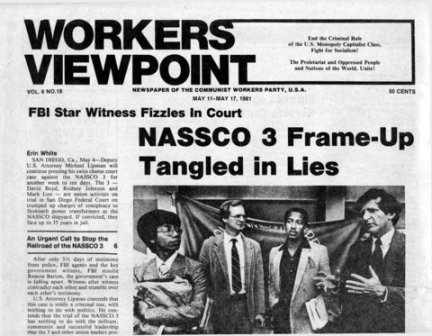
First Published: Workers Viewpoint, Vol. 6, No. 36, September 30-October 13, 1981.
Transcription, Editing and Markup: Paul Saba
Copyright: This work is in the Public Domain under the Creative Commons Common Deed. You can freely copy, distribute and display this work; as well as make derivative and commercial works. Please credit the Encyclopedia of Anti-Revisionism On-Line as your source, include the url to this work, and note any of the transcribers, editors & proofreaders above.
The Ironworkers’ International survived a challenge from the United Shipyard Workers Union (USWU) at the National Steel and Shipbuilding Co. in San Diego, the largest shipyard in the West Coast. “We don’t consider it a loss,” said Miguel Salas, one of the principal leaders of the USWU. “The International should not find any comfort in this vote. It was a vote of fear, fear of what would happen if the USWU won. They [Ironworkers International] ran a scare campaign.”
The results, 1423 for the International, 760 for the USWU, and 17 for no union, was not a victory for the International bureaucrats. In fact, it is an albatross around their necks as they go into sellout negotiations around the contract which expires Sept. 31. The challenge from the independent USWU forced the International to promise wage parity for the Ironworkers at NASSCO with the rest of the west coast shipyards. Currently, the ironworkers are almost $5.00 behind. The International is incapable of delivering this along with other issues like health and safety and pension benefits. The heated campaign also forced the bureaucrats from the seven unions to do joint negotiations for the first time ever in the yards. But without the Ironworkers to paceset the contract as they have done in the past under the leadership of USWU leaders, they will not be able to take advantage of or use this “paper unity.”
Gwen Ferguson, a member of the USWU steering committee said, “When the negotiations come around and there is a new contract, the International will prove that we are right. And we’ll be there.” The steering committee of the USWU remains united and has vowed to challenge the trusteeship imposed by the Ironworkers’ International on local 627. Plans were discussed immediately after the elections to form a caucus and to run for leadership in April when the trusteeship is scheduled to be lifted.
It was not the promises of pies in the sky that won the votes for the International. They, with their front group, the NASSCO Workers for a Better Contract (NWBC), and the bureaucrats of the six other unions in the yards ran a fear campaign aimed at the younger and newer workers who did not know the history of struggle at the yards. They also appealed to the vacillations of many workers about the lack of “legitimacy” (AFL-CIO backing of the USWU). The fear campaign focused on threats of isolation from the International unions and the AFL-CIO if the USWU won. On the final day before the elections Cesar Chavez of the United Farms Workers Union sent a letter via a national representative declaring support for the International against the USWU.
The International bureaucrats also resorted to red and terrorist-baiting and tried to use racism to split the workers. At a rally called by the International to read Chavez’s letter, a racist supporter got on the same stage as the UFW representative and shouted, “Get the commies out, I’m white and I’m proud.” Over 200 USWU supporters drowned out the rally and forced the speakers to abandon the sound truck in a hurry. Chavez’s letter was never read.
On election day itself, the company and the International collaborated to bring out the previously inactive workers to vote. Department after department was shut down as workers were escorted by the foremen, International shop stewards, and business agents to the voting booths. This accounted for the over 80 percent turnout. While the USWU was only allowed 10 observers to be freed from their jobs to watch the voting at the booths, the International had free rein all over the yards with their shop stewards, their officers and the company foremen. First shift stewards were allowed to stay on at second shift and so on. The USWU had no shop stewards since they were all removed by the International during the trusteeship. Organizers were forced to stay at their jobs, except for the observers.
The 760 votes for the USWU were a victory for the independent union drive at NASSCO. It represented a united front of old rivals – Marcos Juarez and Miguel Salas – who stood together in spite of the vicious scare campaigns and repeated overtures from the company and the International to split. While the International’s votes were based on superficial fears, those who voted for the USWU represented the past 10 months of intense class struggle at the yards. The number of voters for the USWU was more than double those who voted for the Strongback slate back in December of 1980.
Through this campaign, the USWU emerged as the most solid and consistent opposition to the sellout bureaucrats. Turncoats like the NWBC, who cried that they were independent at the beginning of the campaign, ended up watchdogging for the International while the bureaucrats went to their convention in Florida and were appointed as observers for the elections by the International. In fact, they were the only active campaigners in the yards for the International except for the right-wing racists. The coming weeks of contract negotiations and the inevitable sellout by the International will swing over many of those who voted out of superficial fear. Next time, they will vote based on their own bitter experience and on the realities and necessities of the ’80s.